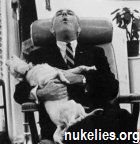In order to take photographs of the strike, each B-29 was carrying two photoflash bombs mixed within the bombload. {NB - Korean War. Rerev] The photographs from the first two B-29s showed a supply train crossing the bridge. Bombs from the first two B-29s straddled the bridge while the trailing B-29's bombs struck the bridge dead center. The trailing bomber's tail gunner had a bird's-eye view of the spectacular result: The train crossing the bridge disappeared in a series of explosions and the violent secondary detonation of its load of ammunition. The tail gunner reported that the explosions turned the black night into day for almost 30 seconds.
https://www.jcs-group.com/military/war19 ... ngb29.html
Illumination - Fillers that when ignited produce a bright light. Illumination rounds are used to provide light for night missions and are found in many different configurations. The most common ordnance that has illumination fillers includes mortars, projectiles and projectiles. Illumination projectiles usually have a time fuze, which ignites the filler at a pre-determined time after it has been deployed and a parachute, which slows the projectiles decent thus providing longer illumination. On a range it is common to find projectile bodies that are left over from a successful illumination function as well as ordnance where for some reason or another the illumination filler did not burn. Although UXO with illumination fillers as less hazardous than high explosives rounds they can still be extremely dangerous and should be dealt with accordingly.
https://uxoinfo.com/uxoinfo/ordfillers.cfm
by 2nd Lt. Amy Gonzales
16th Special Operations Wing Public Affairs
2/23/2006 - HURLBURT FIELD, Fla. (AFPN) -- Explosive ordnance disposal Airmen with the 16th Civil Engineer Squadron destroyed a World War II-era explosive device found in Pensacola.
The 100-pound photo-flash bomb, common to the World War II or Korean War period, was found by construction workers Feb. 14 clearing storm debris in the waters of Santa Rosa Sound on Pensacola Beach.
https://www.af.mil/news/story.asp?id=123016426
https://www.af.mil/photos/mediagallery.a ... 5&page=125
(See last photo. Also not 'ball of fire' photo.)
M-46 photoflash bomb
(United States)
Notes: The M-46 was used during and after WWII for nighttime reconnaissance. It was filled with potassium perchlorate, detonated by a small black powder booster attached to the M-111 mechanical timer fuse. As it’s name implies, the 100lb M-46 produced an extremely bright (½ million candlepower) light for photography. The flash lasted less than 1 second. It was used for both reconnaissance and BDA (battle damage assessment) after air raids.
American ground crewmen did not like handling the M-46 as it was extremely fragile and sensitive to being jarred. An accidental detonation could obviously cause eye injury and the filler itself is slightly toxic.
https://www.harpoondatabases.com/Encyclo ... y2731.aspx


